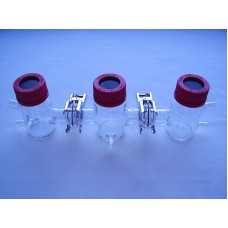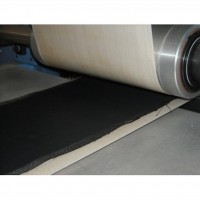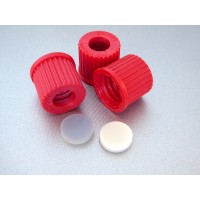Dreikammer-mikrobielle-Brennstoffzelle mit drei GL14 Anschlüssen pro Kammer und Zwischenkammer. Die Kammern sind über Dichtungsringe verbunden, was ein Auslaufen mit geklemmten Membranen verhindert. Stahlklammern verbinden die Seitenarmflansche sicher und stabil.
Jede Kammer hat ein Volumen von 100 ml, basierend auf Standardlaborflaschen mit GL45 Verschluss. Die Flansche erlauben eine flexible Verbindung je nach Testbedingung und können später getrennt und über Membranen miteinander verbunden werden. Die GL Veschlußsysteme können auf Kundenwunsch angepasst werden.
Ein Reaktorsystem besteht aus
- 2 Seitenkammern, 100 ml
- 1 Mittelkammer, 100 ml
- Öffnungen oben, GL45 Gewinde
- 1 Seitenarm/Flansch GL45 mit Dichtungsrille pro Seitenkammer
- 2 Seitenarme/Flansche GL45 mit Dichtungsrille pro Mittelkammer zur Verbindung mit den Seitenkammern
- 3 Zugänge mit GL14 Gewinde pro Seitenkammer für Schlauchanschlüsse
- 2 Zugänge mit GL14 Gewinde an der Mittelkammer für Schlauchanschlüsse
- Zubehör: Schraubverschlusskappen mit und ohne Loch, Septae, Dichtungsringe, Schraubklemmen
Anordnung der 3 Zugänge an den Seitenkammern: 2 Zugänge gegenüber dem Seitenarm, wobei 1 Zugang unten und 1 Zugang oben angeordnet ist. Der 3. Zugang ist oben mittig im 90 Grad-Winkel zwischen dem Seitenarm und dem oberen Seitenport angeordnet.
Anordnung der 2 Zugänge an der Mittelkammer: zu sich selbst gegenüberliegend, mittig zwischen den Flanschen, 1 Zugang unten und 1 Zugang oben.
Eine mikrobielle Brennstoffzelle (MBZ) bzw. eine biologische Brennstoffzelle ist ein bioelektrisches System, in welchem Mikroorganismen ihre Substrate (Zucker, Proteine, Metalle, etc) in Elektrizität umwandeln. Ein bioelektrisches System besteht aus wenigstens zwei Elektroden, einer Anode und einer Kathode. Die Elektroden können aus verschiedenen Elektrodenmaterialien hergestellt werden, z.B. aus Kohlenstofftuch, Kohlepapier, Graphitstab usw... Mikroorganismen können in Substratlösungen auf Elektroden wachsen, wo sie eine große Vielzahl natürlicher Materialien in Energie, Wasser und Kohlendioxid überführen. Die Mikroben verwenden nur einen Teil der erzeugten Energie, um Nährstoffe zu verarbeiten und ihr Leben zu erhalten. Über MBZ kann die restliche Energie zur Stromerzeugung genutzt werden. MBZ bieten ein breites Anwendungsspektrum, wie Abwasseraufbereitung und Energieerzeugung, Unterwasserenergiebedarf, Biosensoren, Strom für implantierte medizinische Geräte usw. H-Zellen sind entsprechend der Form der Zelle definiert. Sie können als Reaktor und andere elektrochemische Zellen verwendet werden. Zusammengebaute H-Zellen haben auf jeder Seite der Kammer ein Volumen von 100 ml. Das kompakte Design der H-Zelle eigneten sich besonders für Forschung und Entwicklung, um erste Ergebnisse effizient zu erzielen. Es ist für die Verwendung verschiedener Substrate geeignet, wie Basalmedium, komplexe Medien und anderes Wachstumsmedien. Abwasser oder organische Flüssigkeiten aus der Natur, natürliches Meerwasser usw. sind ebenfalls moeglich.
Siehe auch FE010561.
Dreikammer-mikrobielle-Brennstoffzelle (MBZ)
- Artikelnr. FE010717
- Verfügbarkeit Lagernd
-
1.547,00€
- Netto 1.300,00€
Ähnliche Produkte
Lochkappen, Schraubverschluß, GL 45, hitzebeständig, rot, 12 Stück
Hochtemperatur-Lochkappen für Medienflaschen:Farbe: rotGL 45-GewindeMaterial Polybutylenterephthalat..
117,81€ Netto 99,00€
Mikrobielle Brennstoffzellen (MFC/MEC)
Die mikrobiellen Brennstoffzellen sind im Wesentlichen modifizierte H-Zellen, die mit verschiedenen ..
0,00€ Netto 0,00€
Referenzelektrode, Ag/AgCl, BASi® RE-5B
Diese Ag/AgCl Referenzelektroden eignen sich für elektroanalytische Chemie, Flüssigkeitschroma..
214,20€ Netto 180,00€
Mikrobielle Brennstoffzelle, Elektrolyseur, MFC/MEC
Diese mikrobielle Brennstoffzelle (MFC/MEC) besteht aus 2 Hälften mit einem Volumen von je 100 ml.Im..
416,50€ Netto 350,00€
Kohlenstofftuch, Gasdiffusionsschicht, ELAT LT1400
Die ELAT® LT1400 ist eine Kohlenstofftuch-Gasdiffusionsschicht (GDS) mit einer mikroporösen Kohlenst..
214,20€ Netto 180,00€
Schraubverschlusskappe GL14 mit Bohrung und Dichtscheibe
p { margin-bottom: 0.25cm; line-height: 120%; }a:link { Schraubverschlusskappe Gewinde: GL 14 ..
4,88€ Netto 4,10€
Schnellsuche mikrobielle Brennstoffzelle, mikrobielle Elektrolysezelle, MBZ, MEZ, GL45, GL14






%20Kopie%202-200x200.jpg)



